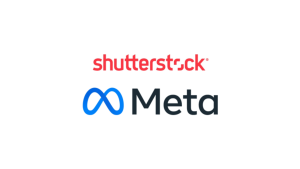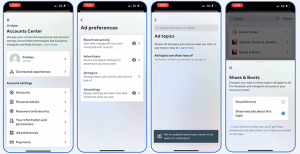With all the madness of the festive season now merely a distant memory, it’s back to business. There has been a lot of gardening work going on in the social sphere, with lots of platforms looking into their rules and regulations. And with the growing popularity of AI generated content, this will make for an interesting read!
Meta Signs New Deal with Shutterstock Over Usage of Content for AI Creation Tools
With generative AI tools hitting the market with a bang across various social outlets, you can bet that all the major tech giants are assessing their options on the same and how they can incorporate AI elements into their platforms. Meta is most definitely among them.
Meta have announced that they have signed a new deal with Shutterstock, that will allow Meta to utilise Shutterstock’s library of visual and audio content. Shutterstock stated that this new partnership “will allow the two companies to bring new creative offerings to market, build on Shutterstock’s ecosystem to compensate and connect contributors to creators, and enable Meta to use Shutterstock’s expansive content library to develop, evaluate and train its machine learning capabilities.”
This is a significant announcement as, Getty Images, one of Shutterstock’s main competitors, is currently embroiled in a lawsuit against Stability AI, over alleged misuse of its content to create AI generated content. If Getty can prove its case, that’ll be a significant blow for Stability’s AI tools, as you would assume it’ll then need to remove all Getty content from its reference material.
It’s impossible to know the full ins and outs of this, but the case does underline the rising demand for more accountability, and compensation for creators, amid the rise of AI tools.
For Meta’s part, it’s keen to bring Shutterstock’s content into its creative tools, aside from AI, with new, integrated options for ads, and other promotional offerings.

Instagram Chief Says Photos Will Get More Focus on the App in 2023
After the major shift toward video content on Instagram in 2022, this announcement comes as a shock if I’m being honest. Good news for the Instagram purists though! IG Chief Adam Mosseri says that the platform has gone too far on pushing videos and will look to make photos more of a focus once again in 2023.
Mosseri had this to say on the news, “I think we were overfocused on video in 2022 and pushed ranking too far, and basically showed too many videos and not enough photos. We’ve since balanced, so things like how often someone likes photos versus videos, and how often someone comments on photos versus videos, are roughly equal, which is a good sign that things are balanced.” So, it seems that the update will show photo or video content depending on the individual user preferences.
I’ve mentioned in previous blogs that recently, all social media platforms are becoming carbon copies of each other, so it’s refreshing to see Instagram go against the status-quo and avoiding straying too far from its roots. Instagram first rose to popularity on the back of still images, with users posting their memories (or in my case anything and everything on my first IG account). The rise of Instagram coincided with the development of phone cameras, and as users became more snap happy with their devices, Instagram provided them with a means to share their content.

Meta’s changing the way you serve personalised ads to young users.
In addition to limits placed on interest and activity as targeting parameters, Meta is removing gender as an option for advertisers to reach teens. The change is in effect from next month. After the changes, personalised ads on those apps will only draw on a user’s age and location to determine relevance. According to Meta, location is necessary to assess which products and services are available in a user’s area.
The impact on Meta’s advertisers
From next month, you’ll be able to target users aged 13-17 by age and location only and will no longer be able to serve personalised ads to this demographic based on select in-app activity.
Users over 18 can already opt out of select ad categories like alcohol and gambling. But from March onwards, young users can control the ads they see – but not opt out completely – in virtually any topic group.
Within Meta’s Ad Topic Controls, topics already restricted by Meta will be set to ‘See Less’ by default, so teens can’t opt-in to content that may not be age appropriate.
These changes are the latest effort to build in some after-the-fact privacy protections for Meta’s youngest users. In 2021, Instagram blocked advertisers from targeting teens based on their interests or online activity outside of the app.
Ireland’s Data Protection Commission conducted a two-year investigation into how Instagram handled user accounts for kids aged 13 to 17, particularly the company’s practice of making those accounts public by default and allowing minors who opted into business accounts to share their phone numbers and other contact info.
In December Meta was fined around $400 million for those infractions. At the time, the company said that it planned to appeal and criticized the Irish regulator for punishing the company for its past policies (ones that were likely only changed in the face of looming regulation, convenient!). Kids on Instagram weren’t opted into private accounts or prompted to switch from public to private until well into 2021.
Meta’s incremental changes obviously stop short of turning off ads altogether for teens, a solution that wouldn’t be unreasonable given the risks involved. The company’s decision to stay the course suggests that its youngest users are valuable enough from an advertising perspective that Meta is willing to risk future regulatory wrangling rather than going cold turkey.

EU regulators give warning to TikTok.
Meta isn’t the only platform in the firing line when it comes to data protection. Regulatory pressure is now mounting up for TikTok, with the EU now warning the app that it will need to adhere with its laws and regulations, or risk being banned from the region entirely. I don’t know what I would do if this happened!
EU Internal Market Commissioner Thierry Breton, met with TikTok’s CEO in January, informing him that TikTok will come under specific scrutiny when the EU’s new Digital Services Act (DSA) kicks in in September. The new act will include new provisions for the protection of users, in regard to content, data usage and more. Breton warned TikTok that if the new rules were already in place, TikTok would likely be in violation of them as it stands.
This new legislation is coming into effect as young users can easily access ‘harmful and sometimes life-threatening’ content. If that situation stands, Breton says that TikTok could indeed face a full ban in the EU. This will have a huge impact on brands and advertisers across the region, so lets all hope that TikTok updates its policies before then.






